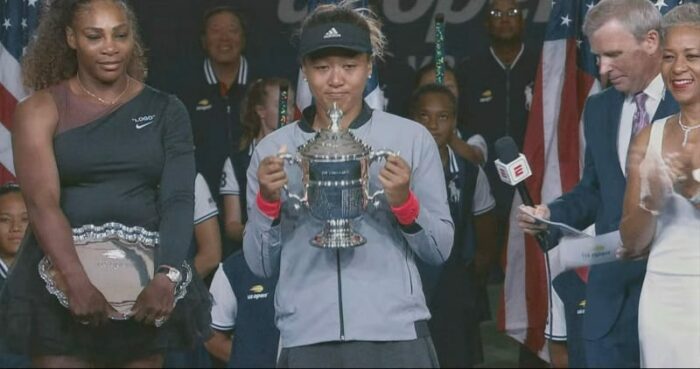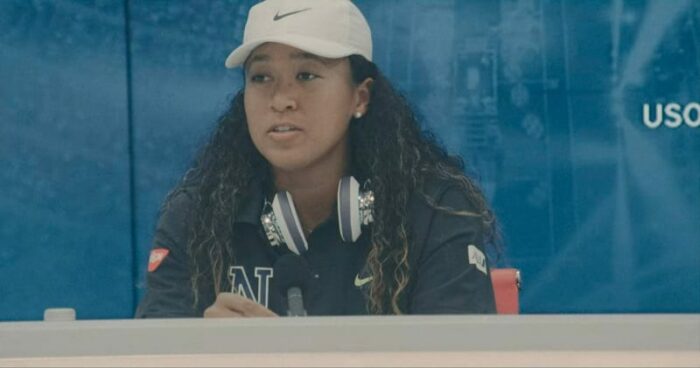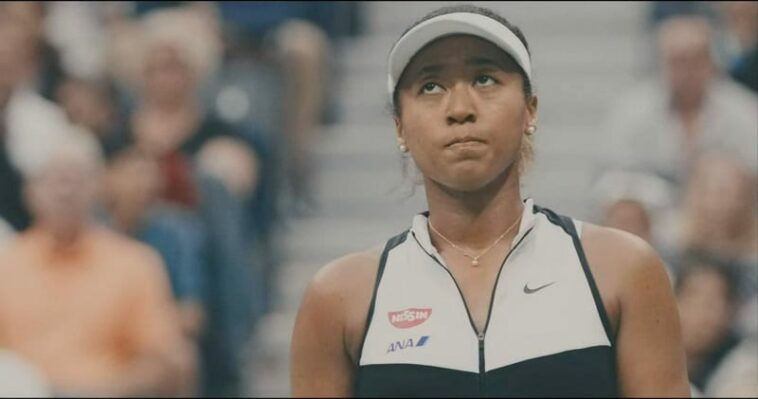Naomi Osaka, the three-part Garrett Bradley-directed docuseries recently released on Netflix, should offer a compelling study. After all, its subject is a four-time Grand Slam champion, a lock for the Hall of Fame, currently the second-highest ranking woman, and poised this month to challenge for Olympic Gold in her native Japan. Osaka is also a charismatic, intriguing public figure who has embraced her mixed heritage (born in Japan and raised in the U.S. to parents of Japanese and Haitian origin), stood at the center of controversy, developed a voice for racial justice, and made as many headlines recently for electing not to play as for holding trophies.
Coming off the elegant, elegiac, and Oscar-nominated documentary Time, director Garrett Bradley would seem well poised to capture the nuance of the enigmatic Osaka, who will at times wear her expressionless reticence as a mask. And the docuseries, though no longer than a feature, provides some candid insights and revealing moments. But oddly, Bradley largely ignores the controversies of the 2018 US Open Final, glosses over some of the thornier aspects of being an outspoken female athlete, and concludes without any attention to Osaka’s recent decisions to forego competing in either the 2021 French Open or Wimbledon championships.
Deciding where to begin and when to conclude is always a challenge for the documentarian. Considerations of contracts and access can often trump narrative priorities. For the period it covers, roughly from the 2018 to the 2020 US Opens, Bradley provides plenty of intimate, fly-on-the-wall moments between Osaka, her coach(es), parents, trainer, and friends. But Osaka’s expressionlessness and reticence work against the goals of the documentary. A subject who prefers headphones to conversation and distance to exuberance makes for a challenge, and only really in the third episode does Osaka herself open up.
To get there, though, will require some patience. Bradley opens the series with a few minutes of charming childhood home video of Osaka and her sister dutifully playing before cutting to the 2018 US Open Final, Osaka’s first major championship. One need not be a historian of the sport to recall its controversies when Osaka’s opponent Serena Williams was penalized a game and the crowd erupted in boos that lasted through the trophy ceremony.
Williams’ celebrity and accomplishment, combined with her contentious history at the event and the crowd’s general lack of understanding of tennis’ clearly defined penalty system, made for a harrowing experience for the much-younger Osaka. Social media was ablaze with accusations of racism and sexism against the sport’s officiating for weeks. And largely overlooked was the simple fact that Osaka, with her strong serving and impeccable ground game, had simply outplayed Williams, routing her in fact, throughout the match, well earning her first Grand Slam trophy.

The moment clearly impacted a shaken Osaka profoundly. To play so perfectly yet showered with boos? To judge from Bradley’s presentation of the event, though, there was no controversy—no point penalties, no furor, no emotion, no trauma. At a moment when Osaka became the first Japanese woman to hold a Grand Slam trophy, she would recall in the press that “it wasn’t necessarily the happiest memory.” The episode presents the victory but none of the attendant controversy or apparent trauma.
More recently, those obligatory and sometimes insensitive press conferences have caused Osaka to forego contesting either the 2021 French Open or Wimbledon events. Following a terse exchange between herself and officials, Osaka announced she would rather forego competing than endure the post-match press sessions required by the events. Her decision was nearly unprecedented in the sport’s history. Rarely has a major champion elected voluntarily not to compete in protest. Nothing in Bradley’s docuseries explicitly addresses this growing conflict between Osaka’s mental wellness and the traditional demands of the sport, though. We see a few awkward moments with the press, a glimpse or two of candor, and a brief indication of the challenges of taking a public stance on racial justice.

As the series progresses, there’s a bit more insight on Osaka’s developing rivalry with the younger Coco Gauff, her grieving the loss of mentor Kobe Bryant, and her joining the worldwide Black Lives Matter protests in the wake of George Floyd’s murder. Unlike in team sports where each athlete has the benefit of others’ wisdom, experience, and support at the ready, a tennis player takes on these challenges largely on her own. For Osaka to do so at her young age—and at some risk of rebuke—is commendable. The tour needs for its players to lead on matters both intrinsic and extrinsic to the game, and Osaka has the championship credentials and social conscience to become a true leader in the years to come.
Aside from the series’ reticence on the on-court controversies and mental health challenges Osaka has faced, Bradley makes a few other curious aesthetic choices. The color correction here may have you searching your television’s menus to see what’s wrong with your settings. Nearly the whole film looks muted down to a subdued, washed-out palette devoid of contrast or saturation. Even network broadcast footage is corrected this way. I’m not sure what the intent was, but the result is strange for a sport where athletes take the court in fluorescent neon fuchsia and chartreuse. The musical score by Devonté Hynes and Theodosia Roussos throbs and pulses for most of the series’ 110 minutes but only occasionally lends impact to the images onscreen.
The sound design includes some faux effects that may go unnoticed by most but that will surely vex knowledgeable fans. In a montage of points from the 2020 Australian Open rematch with Gauff, an umpire yells “Out!” when Osaka nets the ball. That’s just not how tennis works. These post-production concerns may be small matters, granted. It’s hardly the equivalent of Katie Couric’s having editing in an awkward silence or Morgan Neville’s using Artificial Intelligence to recreate Anthony Bourdain’s voice. But it had me wondering.

For instance, in one scene Osaka is riding in car, listening to headphones, as the audio broadcasts news reports of Bryant’s death. Osaka betrays no visible response whatsoever to the news. Did she hear that news, then, and was there no response? The following scene is of her grieving Bryant, who died just two days after Osaka’s surprise loss to Gauff. Alone on the street, her heartfelt response is touching. Was that, indeed, the moment she learned of the tragedy? Or a simple edit of convenience for narrative expedience?
In part because the series depends a great deal on archival footage to provide basic exposition, and in part because there is so little direct-camera address—only a little from Osaka’s team and less from the subject herself—that the edit has to stitch together content from multiple sources. I find myself wishing for a little more of Osaka herself, simply opening up to Bradley’s camera directly. Naomi Osaka doesn’t provide nearly as much Naomi Osaka as some will want.
Osaka tweeted as the series was released that the film was “in some ways my soul and a reflection of who I am” but also that she was “terrified of this being released.” In a nutshell, that comment summarizes the enigma of Naomi Osaka: a reticent celebrity both eager and terrified to bare her soul to the public. Osaka seems poised at a precipice in her career, capable of contending for any Grand Slam she competes, but at the same time willing to forego competition for the sake of principle. Whether she can find a way to manage her mental wellness while staying at the top of her game and fulfilling the sport’s challenging press obligations is anyone’s guess.
The Netflix docuseries isn’t quite the perfect match of talent between filmmaker Garrett Bradley and subject Naomi Osaka it might have been had it dug a bit deeper at the biggest challenges of the tennis champ’s young career. At most, it’s a partial look at the life of an enigmatic champion. But both Bradley and Osaka have already accomplished much and are poised for more. Let’s hope that the near future features Osaka on court, healthy and well, competing for and defending her crowns, and Bradley back in form with the kind of Oscar-nominated filmmaking she’s proven she can make. In the meantime, Bradley’s Naomi Osaka will satisfy the star’s fanbase if not widen her appeal.

